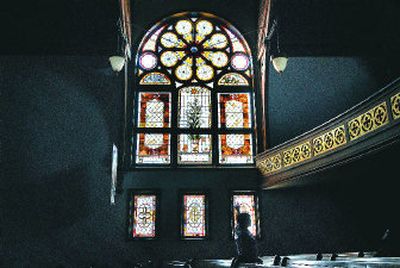Making history by preserving it

When the Fox Theater was threatened with demolition seven years ago, the volunteer Spokane Preservation Advocates put up $2,500 to save it.
It was a small amount compared with the $31 million cost of bringing back the theater, but the money came early and set a tone of generosity.
The contribution was one of the more notable gifts from an organization that in the past decade has become the leading force for historic preservation in Spokane.
The SPA will be celebrating a little history of its own today with a sold-out gala marking its 10th anniversary at the Masonic Temple downtown.
Over the decade, the group has grown to 800 members, who have left their fingerprints on preservation projects throughout the county.
When the historic Westminster Congregational United Church of Christ at Fifth Avenue and Washington Street needed money to restore a large stained-glass window, the SPA gave $5,000.
When the Rookery and Mohawk buildings were threatened with demolition, the group gathered signatures, picketed the property and pressured City Hall to stop the owner from tearing down the downtown structures – even though, ultimately, it could not stop demolition. When a homeowner in Peaceful Valley needed help repainting her old house, SPA members turned out with brushes.
Their motivation is driven by a value that transcends the bottom line.
“People realize how significant these buildings are to our future,” said incoming president Vern Arneson Jr. “They are our identity, our heritage, our culture.”
In 1997, members of the fledgling nonprofit turned out for a cleanup of basalt rock ruins at old Liberty Park, adjacent to Interstate 90 at Third Avenue and Arthur Street. When the freeway was built in the 1960s, Liberty Park was sliced in half, and its historic rock promenade and wading pool were essentially abandoned. The ruins are still there, and the SPA has sought to have them brought back to greater use. The East Central Neighborhood has been awarded a $5,000 grant to repair stair steps and trails there this year.
Similarly, when staff in the city Parks Department discovered other stone ruins on the overgrown hillside in Pioneer Park, the SPA rallied its members to help clear the area for restoration. Because of a large donation from businesswoman Myrtle Woldson, the restoration of the Moore-Turner Heritage Garden will be completed this year.
The SPA spreads its efforts among three areas: monthly hands-on “doing it” projects, heritage fund grants for supporting preservation, and advocacy on behalf of preservation.
Demolition of the Mohawk, Rookery and Merton buildings in downtown Spokane is clearly the group’s biggest loss. The Rookery was torn down a few months ago. The Merton was demolished in 2004. The last pieces of the Mohawk are dropping to wreckers now.
“Everybody is too sick to even go look or drive down that street,” said SPA member Suzanne Markham. “It’s really pretty sad.”
But loss of the Rookery block has an upside.
SPA pushed City Hall to adopt a demolition ordinance prohibiting removal of historically eligible buildings without a plan to replace them with new structures. The ordinance seeks to prevent demolitions to create surface parking lots, which is essentially what’s occurring on the Rookery block.
“What was a success was a demolition ordinance,” said outgoing President Dave Shockley, who helped form SPA.
While the Rookery loss is significant to the SPA, the organization can point to the old Five Mile School as one of its successes.
SPA worked with neighborhood activists and the Mead School District to save the 1939 Five Mile School. It is now a center for a school district partnership that combines home schooling with classroom time. Restoration came as part of a larger voter-approved bond issue.
SPA has supported the 1909 Looff Carrousel at Riverfront Park, relocation of the Moorman House in Cheney for use as a museum, restoration of decorative stone columns in the Rockwood neighborhood and preservation of a brick power building in Rockford. The group also helped underwrite distribution of a 34-page workbook for students on Spokane’s historical architecture and supported historic restoration in Hillyard.
“You can see our footprint in all of these different neighborhoods,” said Arneson, who believes that calling attention to the need for historic preservation is a big part of the battle. He said there is renewed recognition that historic preservation is good for economic growth. “I think one of our successes is definitely raising public awareness,” he said.